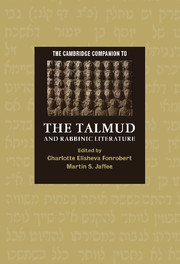Book contents
- Frontmatter
- Introduction: The Talmud, Rabbinic Literature, and Jewish Culture
- Part I: The Conditions of Rabbinic Literary Activity
- Part II: The Genres of Rabbinic Literary Composition
- Part III: Hermeneutical Frames for Interpreting Rabbinic Literature
- 11 The “Other” in Rabbinic Literature
- 12 Regulating the Human Body: Rabbinic Legal Discourse and the Making of Jewish Gender
- 13 Rabbinic Historiography and Representations of the Past
- 14 Rabbinical Ethical Formation and the Formation of Rabbinic Ethical Compilations
- 15 Hellenism in Jewish Babylonia
- Bibliography
- Index
- Source Index
- Series List
12 - Regulating the Human Body: Rabbinic Legal Discourse and the Making of Jewish Gender
from Part III: - Hermeneutical Frames for Interpreting Rabbinic Literature
Published online by Cambridge University Press: 28 November 2007
- Frontmatter
- Introduction: The Talmud, Rabbinic Literature, and Jewish Culture
- Part I: The Conditions of Rabbinic Literary Activity
- Part II: The Genres of Rabbinic Literary Composition
- Part III: Hermeneutical Frames for Interpreting Rabbinic Literature
- 11 The “Other” in Rabbinic Literature
- 12 Regulating the Human Body: Rabbinic Legal Discourse and the Making of Jewish Gender
- 13 Rabbinic Historiography and Representations of the Past
- 14 Rabbinical Ethical Formation and the Formation of Rabbinic Ethical Compilations
- 15 Hellenism in Jewish Babylonia
- Bibliography
- Index
- Source Index
- Series List
Summary
The study of the cultural constructions of gender in rabbinic literature is a relatively young field, certainly compared to other literatures. Although already in the seventies Jewish feminist critics joined their colleagues in different religious contexts to critique the encrusted patriarchal traditions of Judaism, serious analyses of the workings of gender in the literature produced by the Late Antique rabbis began only in the nineties of the past century. Influenced by Michel Foucault's work as well as academic feminist theory, scholars started to move beyond the somewhat one-dimensional analytic and critical categories of “sexism,” “misogyny,” and “patriarchy” that had inspired the earlier feminist critics. Now, Jewish “sexuality” as encoded by rabbinic texts came to have a history and cultural context (Daniel Boyarin, Michael Satlow), as did the Jewish “body,” both male and female (Boyarin, Charlotte Fonrobert). Rabbinic “work” (that is, descriptions of productive labor and laborers) became gendered (Miriam Peskowitz), as did rabbinic thinking about “space” (Cynthia Baker).
Moreover, as gender - defined here as knowledge about sexual difference - has evolved as an analytic category, rabbinic texts have come to be viewed as riddled with tensions and ruptures in gender perspectives. This lends a new dynamic quality to the rabbinic literature. No longer do these texts merely reflect the gender economy of the supposed sociohistoric reality from which they emerge, but they have come to be viewed as actively engaging the various gender possibilities in their cultural universe, favoring some, rejecting others, which however may leave traces within a text.
- Type
- Chapter
- Information
- The Cambridge Companion to the Talmud and Rabbinic Literature , pp. 270 - 294Publisher: Cambridge University PressPrint publication year: 2007
- 14
- Cited by



